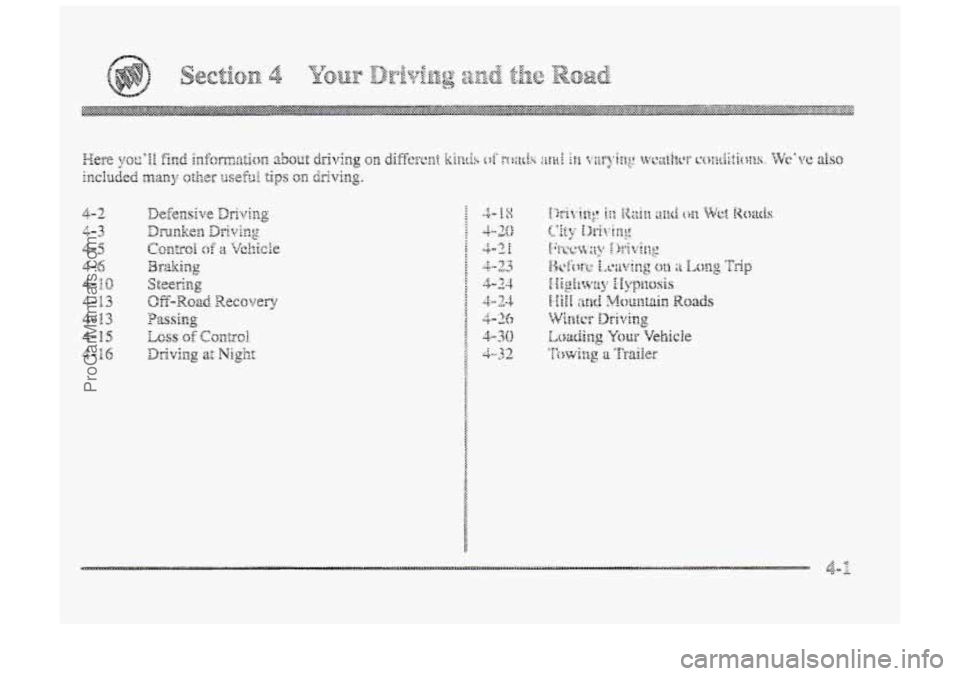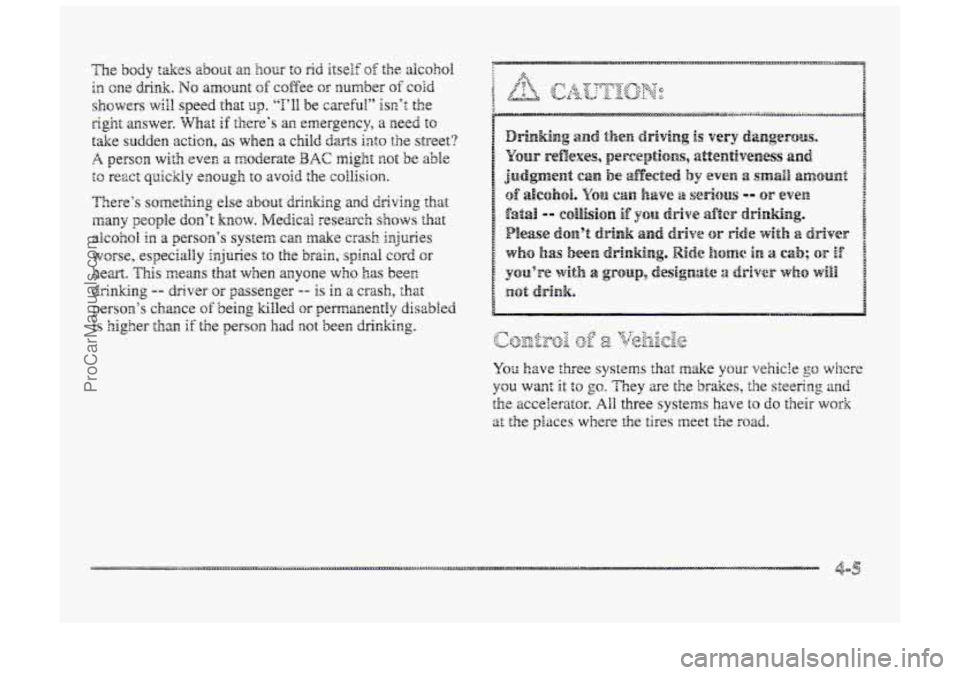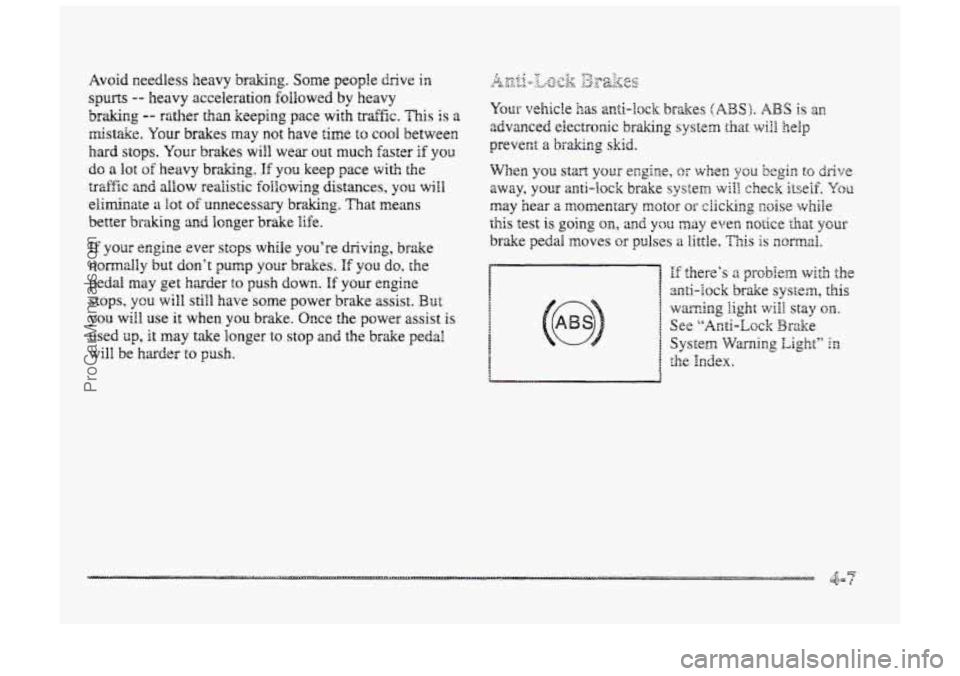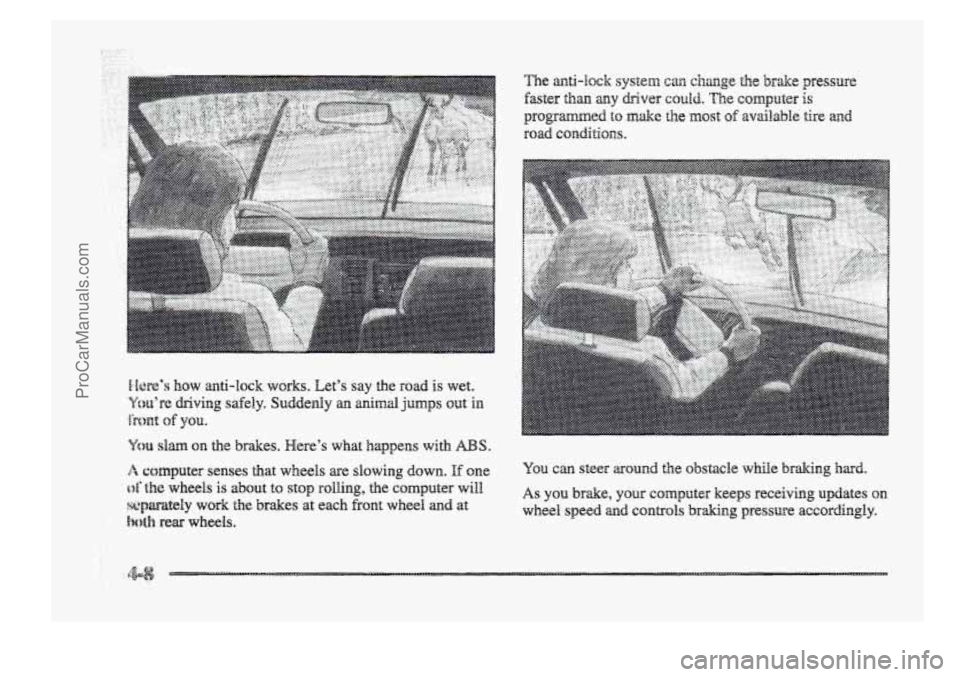BUICK PARK AVENUE 1998 Owners Manual
PARK AVENUE 1998
BUICK
BUICK
https://www.carmanualsonline.info/img/43/57690/w960_57690-0.png
BUICK PARK AVENUE 1998 Owners Manual
Trending: maintenance, cruise control, dimensions, remote start, battery location, stop start, fold seats
Page 201 of 426
Page 202 of 426
Page 203 of 426
4- 2
4-3
4-5
4-6
4- 10
4-43
4- 13
4- 15
4.- I6
ProCarManuals.com
Page 204 of 426
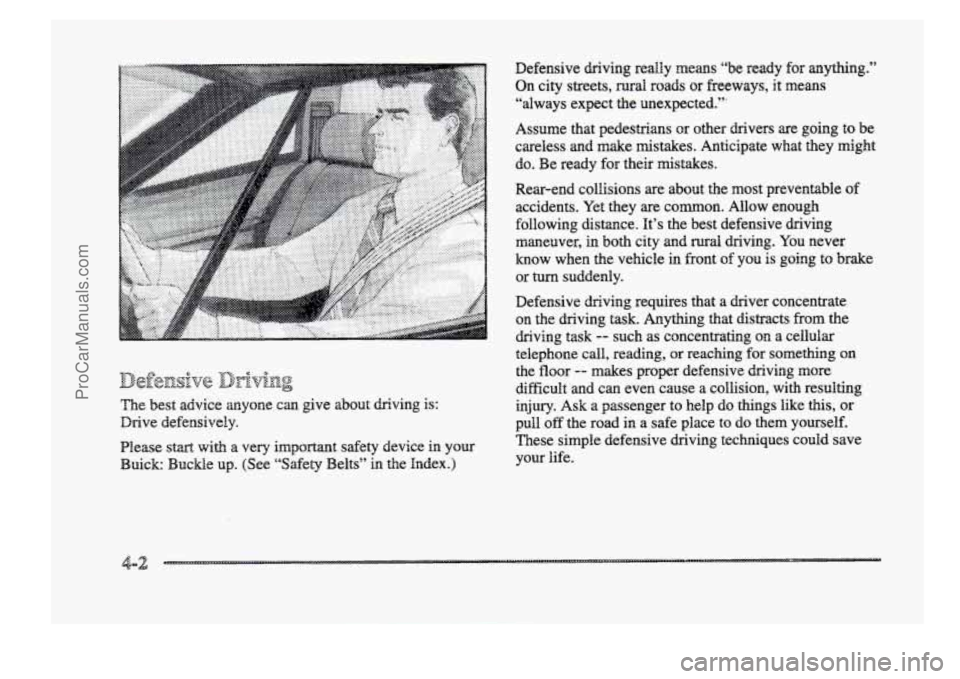
The best advice anyone can give about driving is:
Drive defensively.
Please
start with a very important safety device in your
Buick: Buckle up. (See “’Safety Belts” in the Index.) Defensive driving
redly means “be ready
for mything.”
On city streets, rural roads or freeways, it means
“always expect
the unexpected.”’
Assume that pedestrians or other drivers are going
to be
careless and make mistakes. Anticipate what they might
do. Be ready for their mistakes.
Rear-end collisions
are about the most preventable of
accidents.
Yet they are common. Allow enough
following distance. It’s the best defensive driving
maneuver, in
both city and wd driving. You never
know when
the vehicle in front of you is going to brake
or suddenly.
Defensive driving requires that a driver concentrate
on the driving task. Anything that distracts from the
driving task
-- such as concentrating on a cellular
telephone call, reading, or reaching for something
on
the floor -- makes proper defensive driving more
difficult and can even cause a collision, with resulting
injury.
Ask a passenger to help do things like this, or
pull
off the road in a safe place to do them yourself.
These simple defensive driving techniques coukl save
your Me.
4-2
ProCarManuals.com
Page 205 of 426
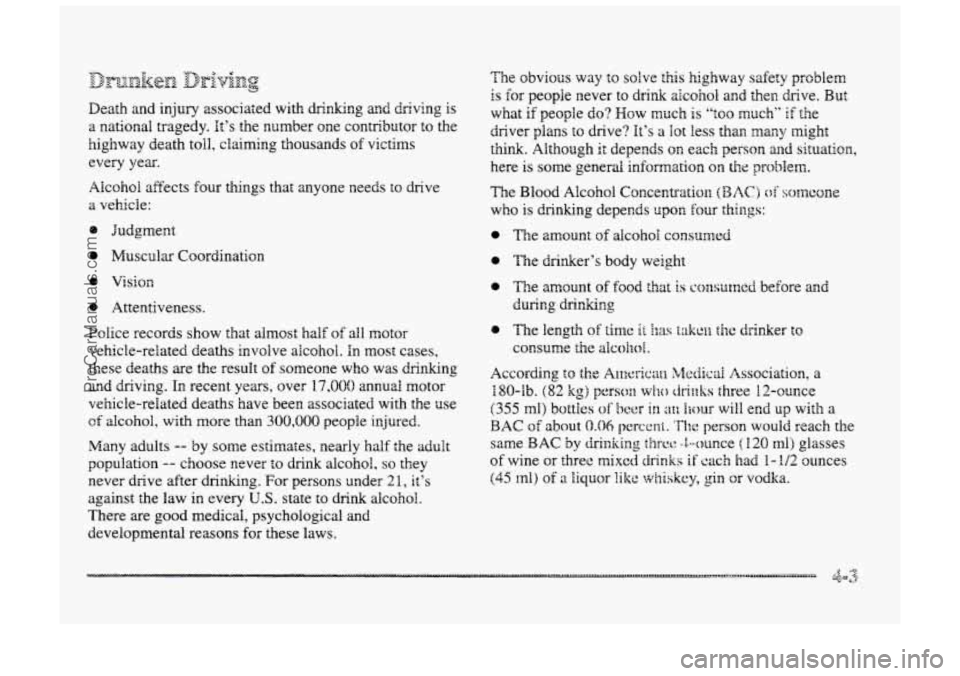
Death and injury associated with drinking and driving is
a national tragedy. It’s the number one contributor to the
highway death toll, claiming thousands
of victims
every
year.
AIcohol affects four things that anyone needs to drive
a vehicle:
0 Judgment
@ Muscular Coordination
8 vision
Attentiveness.
Police records
show that almost half of all motor
vehicle-related deaths involve alcohol. In most cases,
these deaths are the result of someone who was drinking
and driving. In recent years, over 17,000 annud motor
vehicle-related deaths have been associated with the
use
of alcohol, with more than 300,000 people injured.
Many adults -- by some estimates, nearly half the adult
population -- choose never to drink alcohol, so they
never drive after drinking. For persons under 2 I, it’s
against the
law in every U.S. state to drink alcohol.
There are
good medical, psychological and
developmental reasons for these laws.
The obvious way to solve this highway safety pmblem
is for people never to drink alcohol and then drive. But
what if people do? Wow much is “too much“ if the
driver
plans to drive? It’s a lot less than many might
think. Although it depends on each person and situation,
here
is some general information on the problem.
ProCarManuals.com
Page 206 of 426
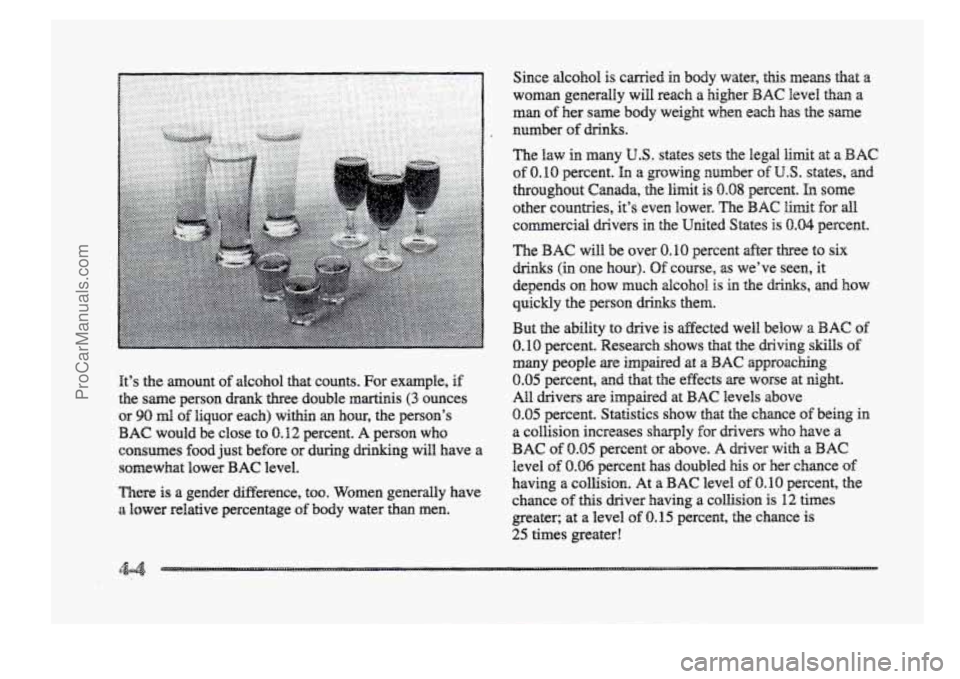
It’s the amount of alcohol that counts. For example, if
the same person
drank thee double martinis (3 ounces
or
540 d of liquor each) within an hour, the person’s
BAC would be close to 0.12 percent. A person who
consumes food just before
or during drinking will have a
somewhat Bower
BAC level.
There is a gender difference, too. Women generally have
a Bower relative percentage of body water than men. Since alcohol
is carried in body water, this means that a
WQ~ZUI generally will reach
a higher BAC level than a
man of her
same body weight when each has the same
number of
chinks.
The law in many U.S. states sets the legal limit at a BAC
of 0.10 percent. Hn a growing number of U.S. states, and
throughout Canada, she limit is 64.08 percent. Ina some
other countries, it’s even Bower. The
BAC limit for all
commercial drivers in the United States is 8.04 percent.
The
BAC will be over 0.10 percent after three to six
drinks (in one hour). Of course, as we’ve seen, it
depends
on how much alcohol is in the drinks, and how
quickly the person drinks them.
But the ability to drive is affected well below a BAC of
0.10 percent. Research shows
that the driving skills of
many people are impaired at a BAC approaching
0.05 percent,
and that the effects are worse at night.
All drivers
are impaired at BAC levels above
0.05 percent. Statistics show that the chance of being in
a collision increases sharply for drivers who have a
BAC of 0.05 percent or above. A driver with a BAC
level of 0.06 percent has doubled his or her chance of
having a CO~~S~OIL At a BAC level of 0.10 percent, the
chance
of this driver having a collision is 12 times
greater;
at a level of 0.15 percent, the chance is
25 times greater!
ProCarManuals.com
Page 207 of 426
YO:; have three systems that make YQLX vehick go wircre
you want it to go. They are the brakes, the steering anti
the accelerator. AH three systems have to do their work
at the places where the tires meet the road.
ProCarManuals.com
Page 208 of 426
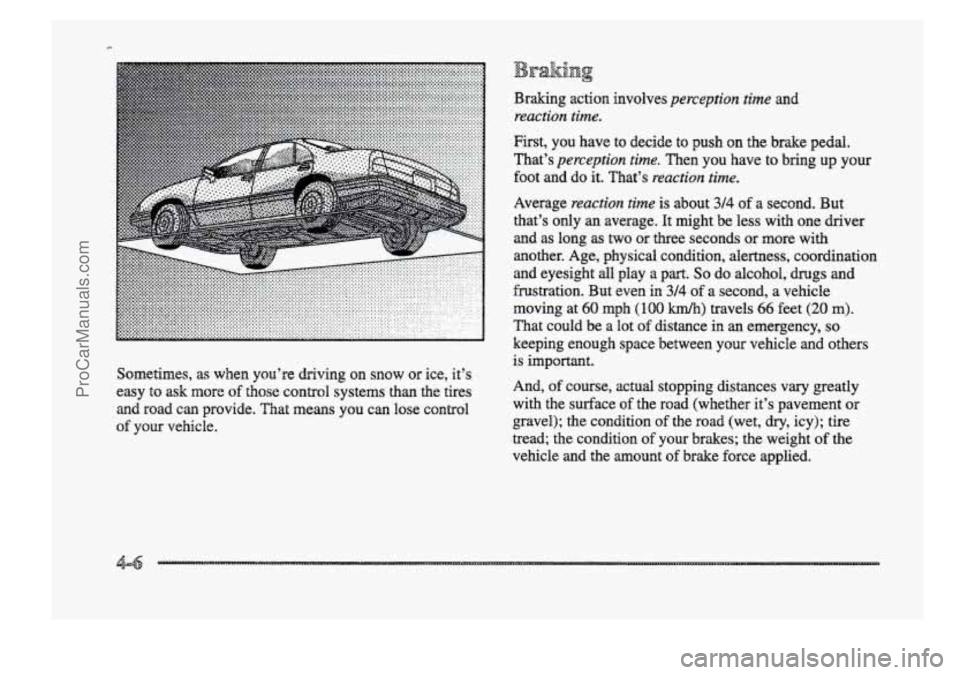
Sometimes, as when you’re driving on snow or ice, it’s
easy
to ask more of hose control systems than the tires
and road can provide.
That means you can lose control
of your vehicle. Braking
action involves perreption
time and
reaction time.
First, you have to decide to push on the brake pedal.
That’s
perception time. Then you have to bring up your
foot and do it. That’s reaction time.
Average reaction time is about 314 of a second. But
that’s
only an average. It might be less with one driver
and as long
as two OS three seconds or more with
another. Age, physical condition, alertness, coordination
and eyesight
dl play a part. So do alcohol, drugs and
frustration. But even
in 3/4 of a second, a vehicle
moving at
60 mpph (100 km/h) travels 66 feet (20 m).
That could be a lot of distance in an emergency, so
keeping enough space between your vehicle and others
is important.
And,
of course, actual stopping distances vary greatly
with the surface
of the road (whether it’s pavement or
gravel); the condition
of the road (wet, dry, icy); tire
tread; the condition
of your brakes; the weight of the
vehicle and the
amount of brake force applied.
ProCarManuals.com
Page 209 of 426
Avoid Reedless heavy braking. Some people drive in
spurts -- heavy acceleration followed by heavy
braking -- rather than keeping pace with traffic. This is a
mistake. Your brakes may not have time to COO^ between
hard stops. Your brakes will wear out much Easter if you
dc a lot of heavy braking. If YOU keep pace with the
traffic ‘ad allow realistic follewing distances, you will
eliminate a lot of unnecessary braking. That means
better
braking and longer brake life.
If your engine ever steps while you’re driving, brake
nomctHBy but don’t pump your brakes. HE you do, the
pedal may get harder to push down. If your engine
stops, you will still have some power brake assist. But
you will use it when you brake. Once the power assist is
used
up, it may take longer to stop and the brake pedal
will be hxder to push.
ProCarManuals.com
Page 210 of 426
..... ... ..,. . ....... .... .... ......
You can steer around the obstacle while braking hard.
As you brake, your CQIII~U~~I- keeps receiving updates on
wheel speed and c~ntgols braking pressure accordingly.
ProCarManuals.com
Trending: engine oil, transmission fluid, clock reset, inflation pressure, washer fluid, jacking, radiator cap


